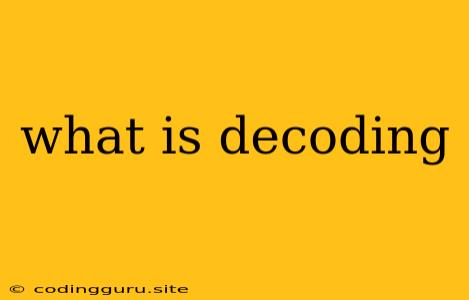What is Decoding?
Decoding, in its simplest form, is the process of converting information from one format to another, making it understandable and usable. Think of it as unlocking a secret message, or transforming a cryptic code into plain text. This process is crucial in various fields, from computer science to linguistics, and plays a vital role in how we interact with information every day.
Why is Decoding Important?
Imagine trying to read a book written in a language you don't understand. You might be able to decipher some words, but you won't be able to fully grasp the meaning. Decoding is like a translation tool that bridges the gap between different forms of information, allowing us to access and understand them.
Here are some key reasons why decoding is important:
- Communication: Decoding allows us to understand spoken and written language. We decode sounds into words and letters into meaning. Without decoding, communication would be impossible.
- Data processing: Computers use decoding to process information stored in different formats. For example, when you download a file from the internet, the computer decodes the data stream into a usable format.
- Problem-solving: Decoding can help us understand complex problems by breaking them down into smaller, more manageable parts. We can analyze data, identify patterns, and find solutions.
- Security: Decoding is used in encryption and decryption to protect sensitive information. By converting data into an unreadable format, it can be safely transmitted and stored.
Types of Decoding
There are many different types of decoding, depending on the context and the type of information being processed. Here are a few examples:
- Text decoding: Decoding written language involves converting letters and symbols into words and sentences. This can include decoding different alphabets, languages, and writing systems.
- Audio decoding: Decoding sound waves involves converting analog signals into digital data. This is essential for storing and playing back music, videos, and other audio content.
- Video decoding: Decoding video streams involves converting compressed video data into images that can be displayed on a screen. This allows us to watch movies, TV shows, and online videos.
- Data decoding: Decoding data involves converting raw data into a format that can be understood and processed by computers. This includes decoding binary data, hexadecimal data, and other data formats.
Examples of Decoding in Everyday Life
Decoding is a ubiquitous process that shapes our everyday experiences. Here are some examples:
- Reading a book: When you read a book, you are decoding letters into words, words into sentences, and sentences into paragraphs.
- Watching a movie: Your TV decodes video and audio signals to display images and sounds on your screen.
- Browsing the internet: Your web browser decodes HTML code to display web pages.
- Using a smartphone: Your phone decodes data to display text messages, make phone calls, and run apps.
Conclusion
Decoding is a fundamental process that underpins our ability to understand and interact with information. It is crucial for communication, data processing, problem-solving, and security. Whether we are reading a book, watching a movie, or using a smartphone, decoding is essential for our everyday lives. It is the invisible force that allows us to make sense of the world around us.
